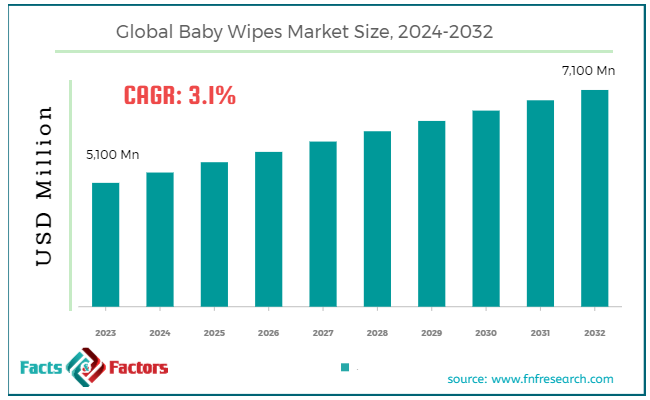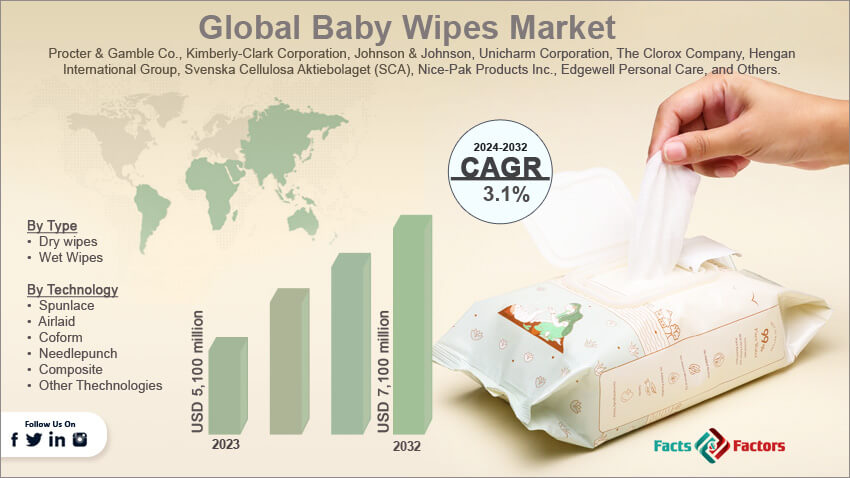Search Market Research Report
Baby Wipes Market Size, Share Global Analysis Report, 2024 – 2032

Baby Wipes Market Size, Share, Growth Analysis Report By Type (Dry Wipes and Wet Wipes), By Technology (Spunlace, Airlaid, Coform, Needlepunch, Composite, and Other Types), By Distribution Channel (Retail Stores and Online Retail), and By Region - Global Industry Insights, Overview, Comprehensive Analysis, Trends, Statistical Research, Market Intelligence, Historical Data and Forecast 2024 – 2032
Industry Insights
[212+ Pages Report] According to Facts & Factors, the global baby wipes market size in terms of revenue was valued at around USD 5,100 million in 2023 and is expected to reach a value of USD 7,100 million by 2032 growing at a CAGR of roughly 3.1% from 2024 to 2032. The global baby wipes market is projected to grow at a significant growth rate due to several driving factors.

 Market Overview
Market Overview
Baby wipes are one of the widely used product in the global child care industry. These wipes are designed to gently clean the delicate skin of young children. These disposable wipes are made from soft non-woven fabric and pre-moistened with a mild solution which ensure a comfortable cleaning at sensitive areas. These wipes are mainly used for diaper changes, feedings, and basic hygiene tasks.
With the growing demand from developing countries, market players are forced to develop advanced baby wipes. These advantages mostly deals with hypoallergenic formulas, biodegradable materials, and specific skin care ingredients. Furthermore, growing demands for environmentally friendly products has triggered manufacturers to produce biodegradable wipes and eco-friendly packaging.
 Key Highlights
Key Highlights
- The baby wipes market has registered a CAGR of 3.1% during the forecast period.
- In terms of revenue, the global wearable technology market was estimated at roughly USD 5,100 million in 2023 and is predicted to attain a value of USD 7,100 million by 2032.
- The global baby wipes is projected to grow at a significant rate due to growing emphasis on product innovation along with the introduction of specialty wipes.
- Based on type segmentation, dry wipes were predicted to hold maximum market share in the year 2023.
- On the basis of technology segmentation, spunlace was predicted to hold maximum market share in the year 2023.
- Based on distribution channel segmentation, online retail was the leading revenue generator in 2023.
- On the basis of region, Asia Pacific was the leading revenue generator in 2023.

 Baby Wipes Market: Growth Drivers
Baby Wipes Market: Growth Drivers
- Growing emphasis on product innovation and the introduction of specialty wipes likely to drive the market growth
One of the key factors fueling the expansion of baby wipes industry is growing emphasis on product innovation. This has triggered manufacturers to constantly unveil advanced wet wipes that cater to countless consumer requirements.
Due to this, companies are focusing to launch new formulas filled with novel properties such as hypoallergenic, natural ingredients, improved pore and skin care, etc. Furthermore, the availability of wipes for a range of applications with environmentally friendly materials are also opening doors for companies to enter into niche markets.
In addition, ongoing expansion of e-commerce platforms is playing crucial role for revenue growth of the baby wipes industry. With the convenience offered by online shopping, it is easy for parents to get access to a range of baby wipe products.
Moreover, manufacturers of baby wipes use various digital platforms to deliver product information about ingredients, user feedback, consumer welfare schemes, and even subscription services. The flexibility in online shopping is expanding reach, improving accessibility, and changing marketing strategies in the baby wipes business.
 Restraints
Restraints
- Increasing awareness and concern about environmental sustainability may restrain the market growth
The global baby wipe industries growth may slow down due to factors such as environmental sustainability. Most the of the conventional baby wipes contain non-biodegradable materials which can pose a potential environmental issue associated with waste disposal/recycling and landfill impacts. With the potential environmental impact of non-biodegradable products and growing consumer awareness for sustainable and biodegradable products, demand for conventional wipes may decrease.
Furthermore, regulatory compliance and facility requirements are a second major priority in this industry. Consumers are becoming increasingly knowledgeable regarding the ingredients in personal care products. This led to a greater level of scrutiny over the safety and transparency about the formulation used in the baby wipes.
However, manufacturers are struggling to keep up with the stringent regulatory standards also to maintain optimum prices. Meeting changing demands while maintaining product efficacy and safety pose great challenge that may affects the production and marketing of baby wipes.
 Opportunities
Opportunities
- Rising trend toward premium and specialty wipes in developing countries to provide growth opportunities
The increasing trend for wet wipes, especially hygienic materials, custom designs, and special skin care formulation likely to increase the baby wipes sale during the forecast period. This trend has been driven by increasing new born population in developing regions and growing disposable incomes. The disposable income in some of the fastest growing developing countries has taken a boost.
For instance, in 2024, the household disposable income per capita in India is forecast to amount to USD 26.97. Similarly, the average yearly disposable income per capita in China's households in 2023 was almost 39,200 yuan. Chinese annual per capita income has increased significantly over the past few decades and is continuing growing quickly.
With growing disposable income, customers are looking for more premium products that offer more features. In addition to this, with increasing awareness of hygiene and health-related issues, particularly in infant care may trigger the demand for specialty wipes. Moreover, with the increasing urbanization and changing lifestyle parents around the developing countries are seeking high-quality products that offer superior cleaning and skin care benefits.
 Challenges
Challenges
- Increasing scrutiny and demand for transparency regarding product ingredients to challenge market growth
The baby wipes industry has good reason to remain vigilant about ingredient transparency and however much legal scrutiny is necessary. Consumers are getting savvier about what's in their non-edible personal care products, baby wipes included, and are worried that they might be loading Junior up with toxins. There's just one thing: Meeting the rigorous, detailed and visible inventory expectations of these products in the face of a rapidly expanding list of required-to-be-disclosed ingredients isn't easy. It takes a prodigious investment in R&D to produce wipes with ingredients that are safe and easy to recognize as natural.
This is not an industry that doesn't also have to reconcile product performance with environmental sustainability. Thanks both to rampant recycling-themed marketing and real environmental concern, there's a new market on the rise for eco-friendly, "biodegradable" baby wipes.
 Baby Wipes Market: Segmentation Analysis
Baby Wipes Market: Segmentation Analysis
The global baby wipes market is segmented based on type, technology, distribution channel, and region.
 By Type Insights
By Type Insights
Based on type, the global baby wipes market segments are dry wipes, and wet wipes. In 2023, the dry wipes category dominated the global market. Large market share of dry wipes indicating that consumer preferences are shifting towards wipes designed for use with liquid solutions. Users can choose their preferred cleaning solution using dry wipes, meeting the growing demand for personalized and potentially more sustainable options.
 By Technology Insights
By Technology Insights
On the basis of technology, the global market segments are spunlace, airlaid, coform, needlepunch, composite, and others. Presently, Spunlace technology is the leader in the technology category. This shows that spunlace technology has a considerable market share in the manufacture of baby wipes. Spunlace technology uses hydro entanglement technology to give the wipes a silky, fabric-like feel. The success of spunlace technology may be attributed to its ability to produce high-quality, long-lasting, soft wipes.
 By Distribution Channel Insights
By Distribution Channel Insights
In terms of distribution channel, the global baby wipes market categorized as retail stores, and online retail. In 2023, online retail surpassed traditional retail and become the most profitable shareholder segment in the world. This marks a huge change in consumer purchasing habits towards digital channels. The ease of use, accessibility, and wide product offerings of e-commerce networks have led to the dominance of online retail.
 Recent Developments:
Recent Developments:
- In 2021, P&G released Pampers AquaPure wet wipes, highlighting that its water content is 99% and there are very few additives. These wipes are suitable for people with delicate skin, especially newborns.
- In 2021, Kimberly-Clark, partnered with UNICEF to help families in need, especially those affected by disasters. As part of the agreement, Huggies agreed to provide baby wipes to vulnerable families, which will help UNICEF support communities during crises and disasters.
 Report Scope
Report Scope
Report Attribute |
Details |
Market Size in 2023 |
USD 5,100 Million |
Projected Market Size in 2032 |
USD 7,100 Million |
CAGR Growth Rate |
3.1% CAGR |
Base Year |
2023 |
Forecast Years |
2024-2032 |
Key Market Players |
Procter & Gamble Co., Kimberly-Clark Corporation, Johnson & Johnson, Unicharm Corporation, The Clorox Company, Hengan International Group, Svenska Cellulosa Aktiebolaget (SCA), Nice-Pak Products Inc., Edgewell Personal Care, and Others. |
Key Segment |
By Type, By Technology, By Distribution Channel, and By Region |
Major Regions Covered |
North America, Europe, Asia Pacific, Latin America, and the Middle East &, Africa |
Purchase Options |
Request customized purchase options to meet your research needs. Explore purchase options |
 Baby Wipes Market: Regional Analysis
Baby Wipes Market: Regional Analysis
- Asia Pacific to lead the market during the forecast period
Asia Pacific is expected to remain the largest revenue generating region in the global baby wipes industry. Rapidly developing countries in the region such as China and India have dense populations with the high new born growth rates. The growing population and rising disposable income in these countries are driving the demand for baby care products, especially baby wipes. Furthermore, the baby wipes market is expected to grow significantly as parents in the region emphasize hygiene and convenience.
Additionally, changing lifestyle trends in Asia Pacific, such as the increase in working parents and increasing awareness of personal cleanliness, are driving the demand for simple and effective baby care products such as wipes. In addition, companies in the region are expected to meet a wide range of customer expectations by developing innovative products, such as wet wipes made from natural ingredients.
 Baby Wipes Market: Competitive Landscape
Baby Wipes Market: Competitive Landscape
Some of the main competitors dominating the global baby wipes market include;
- Procter & Gamble Co.
- Kimberly-Clark Corporation
- Johnson & Johnson
- Unicharm Corporation
- The Clorox Company
- Hengan International Group Company Limited
- Kimberly-Clark Corporation
- Svenska Cellulosa Aktiebolaget (SCA)
- Nice-Pak Products, Inc.
- Edgewell Personal Care
The global baby wipes market is segmented as follows:
 By Type Segment Analysis
By Type Segment Analysis
- Dry wipes
- Wet Wipes
 By Technology Segment Analysis
By Technology Segment Analysis
- Spunlace
- Airlaid
- Coform
- Needlepunch
- Composite
- Other Thechnologies
 By Distribution Channel Segment Analysis
By Distribution Channel Segment Analysis
- Retail Stores
- Online Retail
 By Regional Segment Analysis
By Regional Segment Analysis
- North America
- The U.S.
- Canada
- Mexico
- Europe
- France
- The UK
- Spain
- Germany
- Italy
- Rest of Europe
- Asia Pacific
- China
- Japan
- India
- Australia
- Southeast Asia
- Rest of Asia Pacific
- The Middle East & Africa
- Saudi Arabia
- UAE
- Egypt
- Kuwait
- South Africa
- Rest of the Middle East & Africa
- Latin America
- Brazil
- Argentina
- Rest of Latin America
Industry Major Market Players
- Procter & Gamble Co.
- Kimberly-Clark Corporation
- Johnson & Johnson
- Unicharm Corporation
- The Clorox Company
- Hengan International Group Company Limited
- Kimberly-Clark Corporation
- Svenska Cellulosa Aktiebolaget (SCA)
- Nice-Pak Products Inc.
- Edgewell Personal Care
Frequently Asked Questions

Copyright © 2024 - 2025, All Rights Reserved, Facts and Factors


